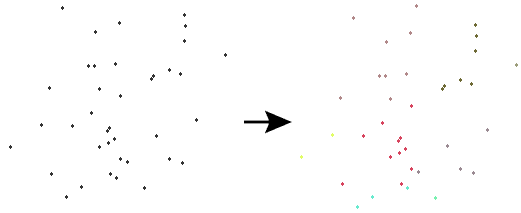Creates aggregates of features based on their proximity to each other. Each aggregate that is created covers approximately the neighborhood width and height (measured in feature ground units).
This transformer is used to reduce the data volume of "wallpaper" types of features that have no individual attributes. The resulting aggregates can be output to a system using many fewer records than if each feature was output by itself. For systems that support aggregates, or multi-part features, this can result in substantial performance improvements and greatly decrease storage requirements.
Parameters
Transformer
Features that leave this transformer will have only the group-by attributes present on them. Any other feature attributes are lost.
Process At End (Blocking): This is the default behavior. Processing will only occur in this transformer once all input is present.
Process When Group Changes (Advanced): This transformer will process input groups in order. Changes of the value of the Group By parameter on the input stream will trigger processing on the currently accumulating group. This may improve overall speed (particularly with multiple, equally-sized groups), but could cause undesired behavior if input groups are not truly ordered.
There are two typical reasons for using Process When Group Changes (Advanced) . The first is incoming data that is intended to be processed in groups (and is already so ordered). In this case, the structure dictates Group By usage - not performance considerations.
The second possible reason is potential performance gains.
Performance gains are most likely when the data is already sorted (or read using a SQL ORDER BY statement) since less work is required of FME. If the data needs ordering, it can be sorted in the workspace (though the added processing overhead may negate any gains).
Sorting becomes more difficult according to the number of data streams. Multiple streams of data could be almost impossible to sort into the correct order, since all features matching a Group By value need to arrive before any features (of any feature type or dataset) belonging to the next group. In this case, using Group By with Process At End (Blocking) may be the equivalent and simpler approach.
Note: Multiple feature types and features from multiple datasets will not generally naturally occur in the correct order.
As with many scenarios, testing different approaches in your workspace with your data is the only definitive way to identify performance gains.
Parameters
These parameters, measured in ground units, divide the input space into cells. The result is a grid of cells that expands in all directions from the origin (0,0). The center of the bounding box of each input feature is used to determine the cell for the feature. Once all input features have been read, an aggregate feature is created from all features in each cell. If linear features are input, they will have pseudo nodes removed from within their cells to further reduce the number of separate entities. No such reduction is done to any polygons or donuts that enter.
Note: To view the grid of cells that is created from these parameters, use the 2DGridCreator. Specify 0,0 for Starting X Coordinate and Starting Y Coordinate, respectively, and the same values for Column Width and Row Height as Neighborhood Width and Neighborhood Height, respectively.
When you set this parameter, neighborhoods with fewer than the specified number of features are merged with a vertical neighbor area in order to increase the number of members. You can prevent this from happening by setting the parameter to 0 (zero).
Example

Editing Transformer Parameters
Using a set of menu options, transformer parameters can be assigned by referencing other elements in the workspace. More advanced functions, such as an advanced editor and an arithmetic editor, are also available in some transformers. To access a menu of these options, click  beside the applicable parameter. For more information, see Transformer Parameter Menu Options.
beside the applicable parameter. For more information, see Transformer Parameter Menu Options.
Transformer Categories
Technical History
Associated FME function or factory: TilingFactory
Search FME Community
Search for samples and information about this transformer on the FME Community.
Tags Keywords: MBR "minimum bounding rectangle" Clumper NeighbourhoodAggregator